By JOE PINKSTONE FOR MAILONLINE
PUBLISHED: 16:39, 22 October 2018 | UPDATED: 18:41, 22 October 2018
- White marble sculptures are synonymous with the Ancient Greeks and Romans
- Scientists now believe these sculptures were originally colourfully painted
- The artwork’s whitewashing stems from romanticising the work of ancient artists
- White marble sculptures have since been adopted as emblems of white nationalism in some alt-right factions
The classic whitewashed marble statues that populate art galleries and museums across the world were once vibrantly coloured.
Ignorance of this fact is being labelled as ‘the most common misconception about Western aesthetics in the history of Western art’ by experts.
Ancient Roman and Greek pieces of art are instinctively assumed to be white by the general public based on their current appearance after centuries in ruin.
Academics delved into the possibility that the statues were colourful – known as polychromatism – and found microscopic evidence of a variety of colours.
A variety of ultra-high resolution imagery was used to detect the presence of past pigmentation.
Alt-right groups have used white sculptures in ancient civilisations as ‘proof’ of white supremacy, which researchers argue has created a ‘blindness’ to the possibility that these sculptures were originally colourful.
This is reinforced by the historical popularity in the art world of neoclassic pieces, rising to prominence in the 18th and 19th Century, which also assumed ancient to works to be devoid of colour.
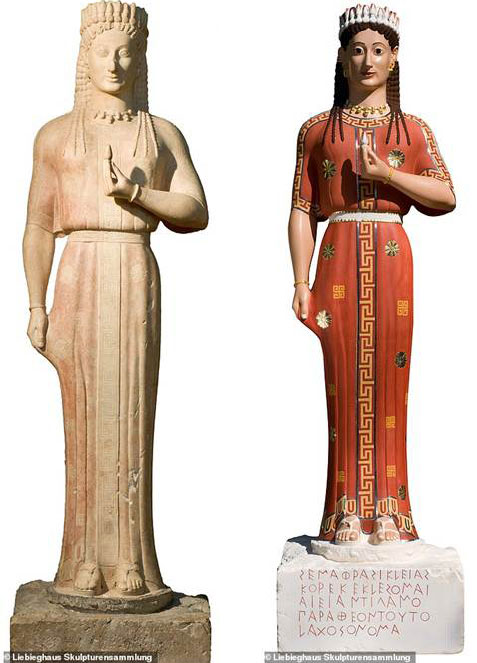
The exhibition known as ‘Gods in Colour’ (pictured) was set-up in 2003 and has since visited 28 cities. It portrayed statues and art with the colouration it would have had when it was first created and before the annals of time erased it from view
Mark Abbe, now a professor of ancient art at the University of Georgia has been investigating the whitewashing of ancient statues.
He told Margaret Talbot of The New Yorker: ‘[It] is the most common misconception about Western aesthetics in the history of Western art.’
He went on to call it ‘a lie we all hold dear’.
Dr Abbe has been studying pigmentation on ancient pieces of art for decades and re-investigated the findings from the ruins at Aphrodisias which was decimated by an earthquake in the seventh century AD.
Remains were studied for the first time in 1961 when archaeologists systematically excavated the city and put thousands of sculptural fragments in storage.
When Dr Abbe went to study the remains several decades later, he found many pieces were splattered with flecks of colour.
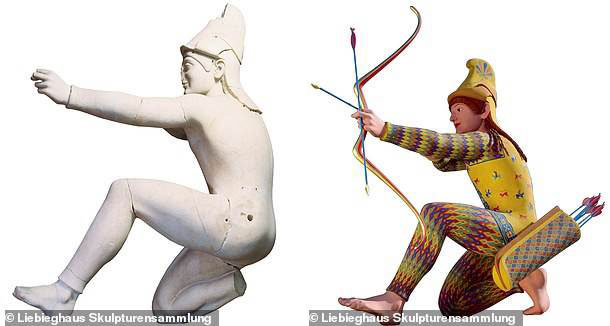
The classic whitewashed marble statues (left) that populate art galleries and museums across the world were once vibrantly coloured (right)
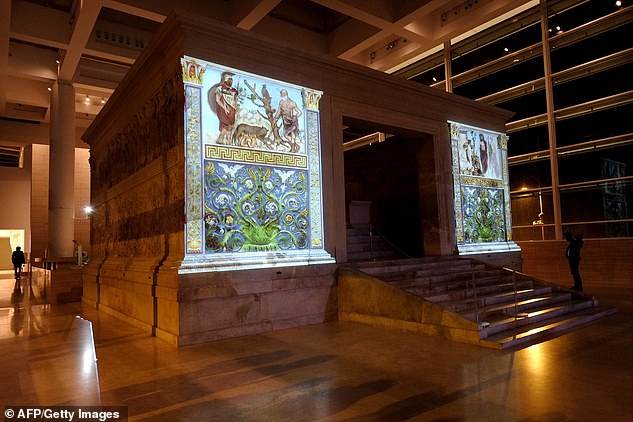
In August 2014 colour was projected onto a set of friezes at the Ara Pacis museum, in Rome (pictured). The removal of colour from ancient artwork has become romanticised and accepted over time.
These included red pigment on the lips of a statue, black pigment on coils of hair and mirror like gilding on some limbs.
Vinzenz Brinkmann, a master’s student in classics and archaeology from Ludwig Maximilian University, in Munich in the 80s reached a similar conclusion.
Dr Brinkmann invented a unique way of looking at the surface of these works of art and found a trove of polychromy.
With his discovery of the unmissable colouration came the simultaneous realisation that this portion of ancient history had all but been erased by time.
He told the New Yorker: ‘It started as an obsession for me that has never ended.’
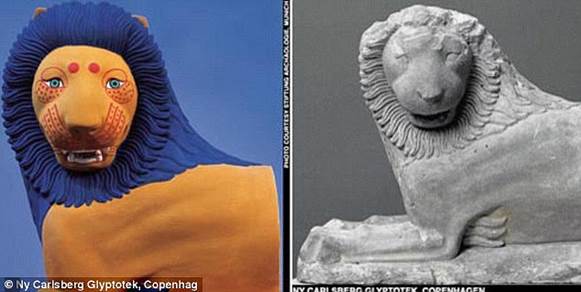
Pictured is a reconstruction of a lion statue that was part of a 2010 museum exhibit in Berlin, Germany. Researchers argue that back in the time of their creation, Roman and Greek monuments were vibrant and multi-coloured
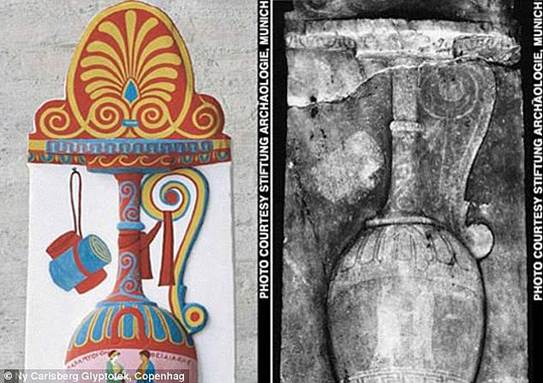
The exhibition featured more than 20 full-size colour reconstructions of Greek and Roman works, alongside 35 original statues and pieces of art
Outrage at the exclusion of this slice of history is not limited to the two individuals who stumbled across the pigmentation over the course of their research.
Jan Stubbe Østergaard, a former curator at the Ny Carlsberg Glyptotek museum in Copenhagen has founded the international research network on polychromy.
‘Saying you’ve seen these sculptures when you’ve seen only the white marble is comparable to somebody coming from the beach and saying they’ve seen a whale because there was a skeleton on the beach,’ he said.
In response to the lack of education around the topic and the widespread omission of fact from textbooks around the world, Dr Brinkmann and his wife Ulrike Koch-Brinkmann started the exhibition known as ‘Gods in Colour’.
This exhibition was set-up in 2003 and has since visited 28 cities.
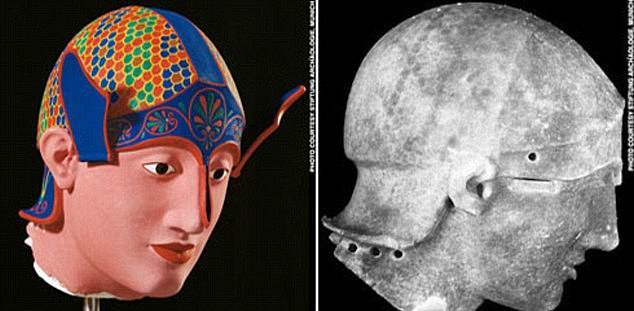
Ancient Roman and Greek pieces of art are instinctively assumed to be white by the general public based on their current appearance after centuries in ruin.
It portrayed statues and art with the colouration it would have possessed when it was first completed and before the annals of time erased it from sight.
Approximations of the original work were done by identifying and applying the pigment that remained on the object and also by studying ‘shadows’ – a tiny change in the surface that can tell experts what type of paint it once housed.
These included a Trojan archer from 500 BC with garishly patterned tights, a lion with ochre fur and the darkly coloured pubic hairs and bronzed skin and nipples of statues depicting a human likeness.
Previous essays and work from academics in the field has tried to reveal the colourful past of both the artwork and the people of ancient civilisations.
One researcher, Sarah Bond, a University of Iowa classics professor, received hate-mail from the ‘alt-right’ white nationalists who condemned her claims.
Professor Bond stressed that these much-touted ancient civilisations often separated people based on their race, but not on their skin colour and that this was subsequently reflected in the art of the era.

This portrait of the Roman Emperor Gaius Julius Caesar Augustus Germanius, known as Caligula, hails from 37-41 A.D. The image on the right shows what it would have looked like originally.
Identity Evropa, an American neo-Nazi and white supremacist organisation, claimed the classical white marble statues were a historical emblem of white nationalism.
The initial acceptance and romanticisation of white marble statues as the ancient norm stemmed from the belief artists deliberately avoided the use of colour in a bid to distinguish their work from the non-Western art and also reaffirm their sense of a superior rationality.
This misheard notion from modern scholars manufactured an elaborate solution to a simplistic issue; the pigment simply eroded away after many years exposed to the elements.
Improvemnts must be made ot the process which is applied when archaeological sites produce a rare sulpture.
Instead of mercilessly cleaning the specimen to determine what they have found, archaeologists should take greater care to not remove the fragile remains of a long-ago paint.
